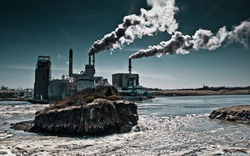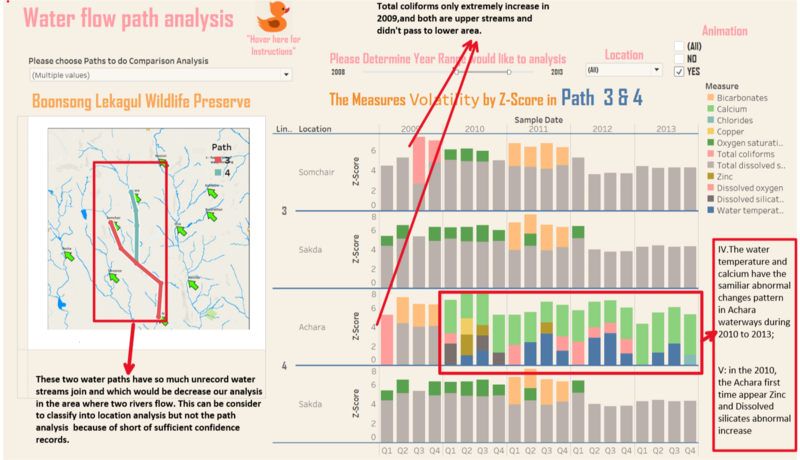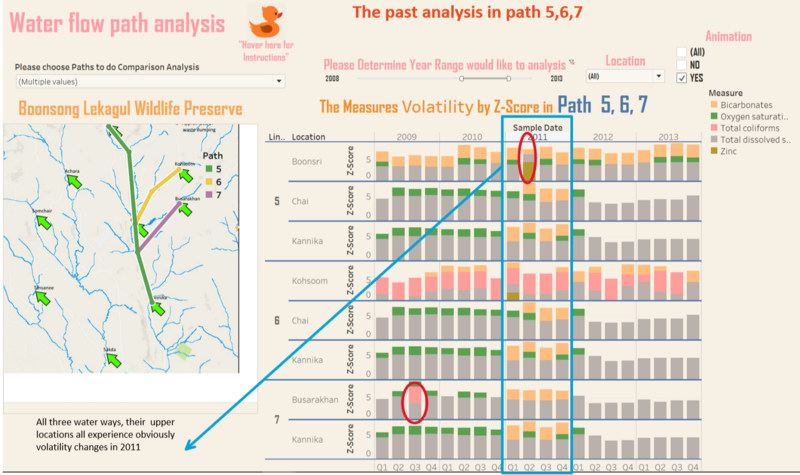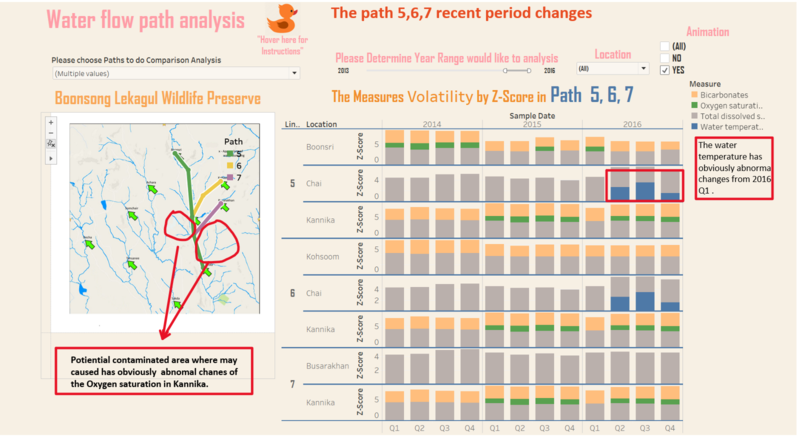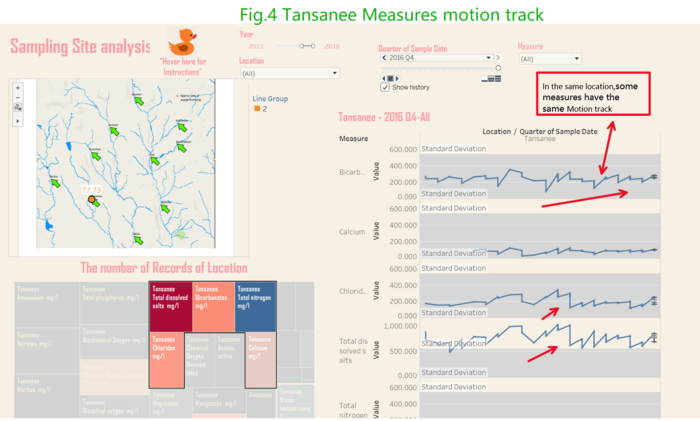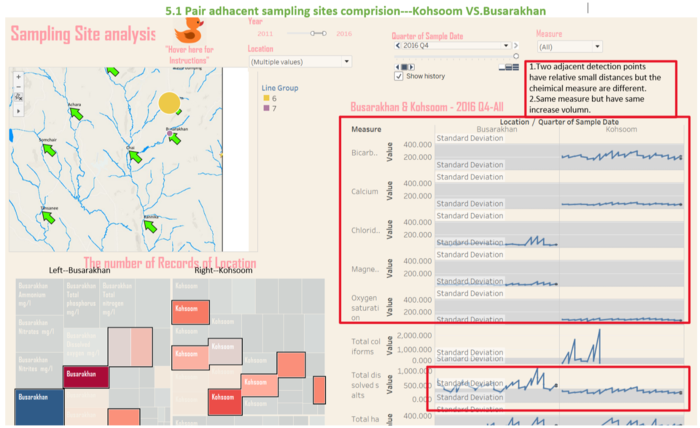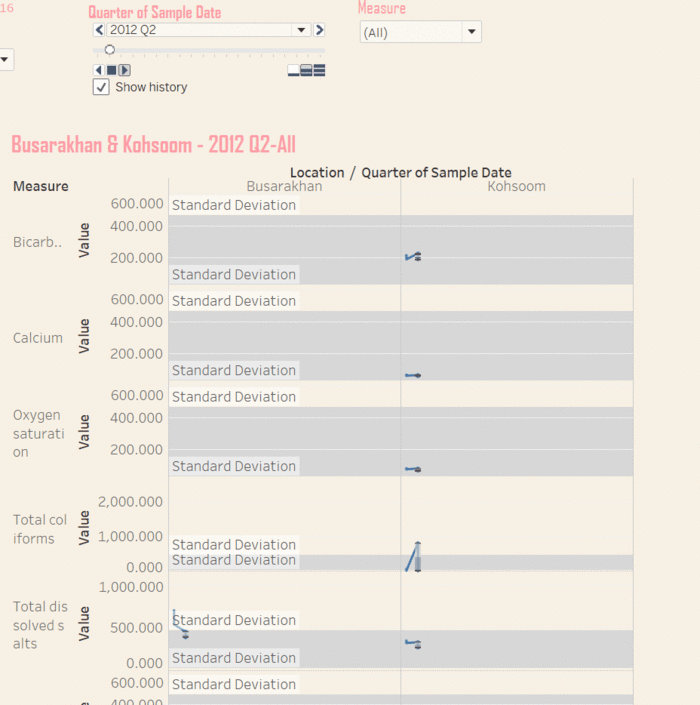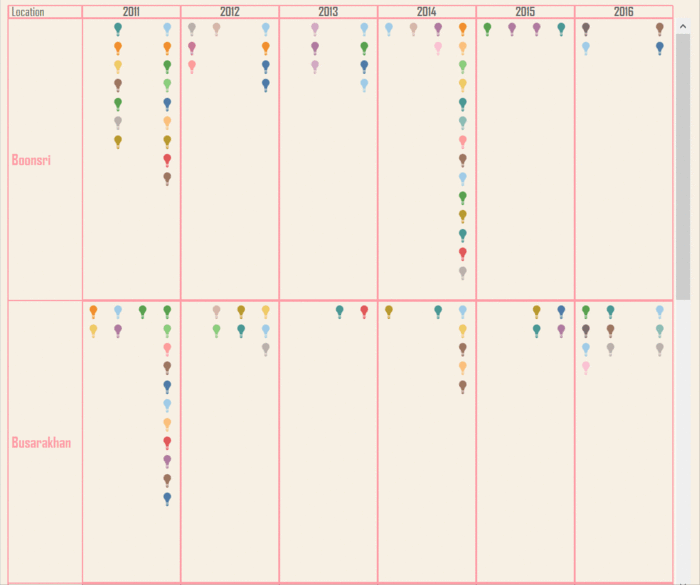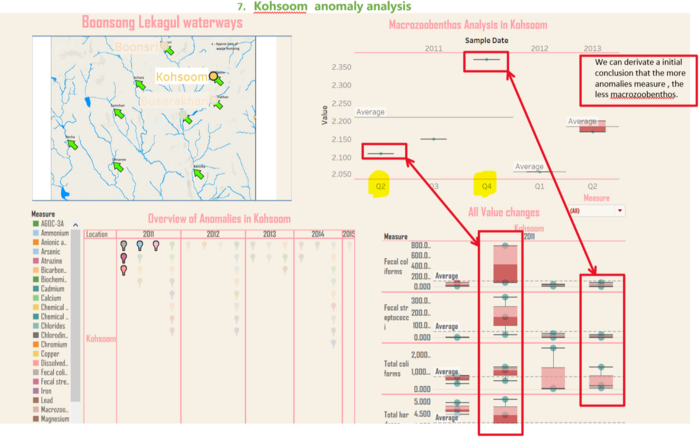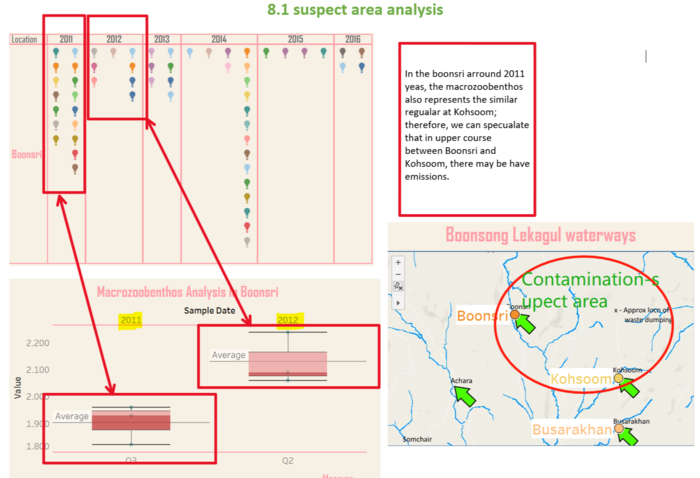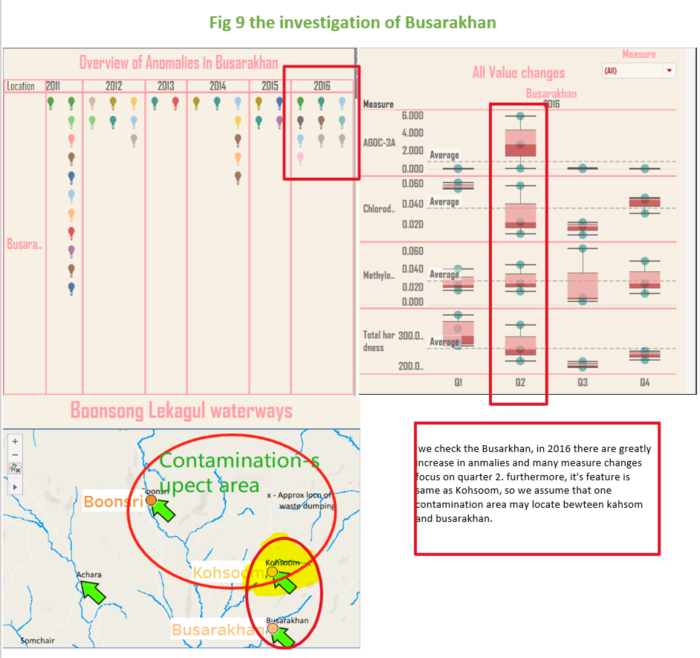Difference between revisions of "ISSS608 2017-18 T3 Assign Liu Yuanjing Visualisations"
Yjliu.2017 (talk | contribs) |
Yjliu.2017 (talk | contribs) |
||
| (10 intermediate revisions by the same user not shown) | |||
| Line 1: | Line 1: | ||
| − | + | ||
| − | <div style=background:# | + | <div style=background:#F9EFE9;> |
[[Image:Water pollution.jpg|250px]] | [[Image:Water pollution.jpg|250px]] | ||
<font size = 5; color="#751102"><span style="font-family:Segoe UI Semibold";> Investigating chemical contamination in the Boonsong Lekagul waterways</span> | <font size = 5; color="#751102"><span style="font-family:Segoe UI Semibold";> Investigating chemical contamination in the Boonsong Lekagul waterways</span> | ||
</font></div> | </font></div> | ||
| − | + | <!----------- Main Header ------------> | |
| − | <!----------- | + | {|style="background-color:#F9EFE9;" width="100%" cellspacing="0" cellpadding="0" valign="top" border="0"; text-align:center;" | |
| − | {|style="background-color:# | ||
| style="font-family:Segoe UI Light; text-align:center;" width="15%" | | | style="font-family:Segoe UI Light; text-align:center;" width="15%" | | ||
| Line 26: | Line 25: | ||
<div style="font-family:Segoe UI; padding: 0px 15px 0px 15px;"> | <div style="font-family:Segoe UI; padding: 0px 15px 0px 15px;"> | ||
<div style="font-family:Segoe UI;"> | <div style="font-family:Segoe UI;"> | ||
| − | <font size = 2; color ="#353839 | + | <font size = 2; color ="#353839"> |
| − | "> | ||
==The Path Analysis== | ==The Path Analysis== | ||
| Line 64: | Line 62: | ||
</tr> | </tr> | ||
</table> | </table> | ||
| + | |||
| + | |||
| + | |||
=Location Analysis= | =Location Analysis= | ||
| Line 72: | Line 73: | ||
<th>Visualization</th> | <th>Visualization</th> | ||
<tr> | <tr> | ||
| − | <td> <b>1. | + | <td> <b>1.Single Location Analysis </b> |
| − | <br>Fig | + | <br>Fig 4 provides the information about the measure in Tansanee. the below treemap has show the measures that increase or decrease relative higher than others and color highlight the number of record of the measures. The whole picture has tell us that in the same location, some measures has similar motion tracks. </td> |
| − | <td>[[File: | + | <td>[[File:Tansanee measure.png|700px|center]]</td> |
| + | </tr> | ||
| + | <tr> | ||
| + | <td> <b>2. Pair Comparative Analysis-1 </b> | ||
| + | <br>Fig 5.1 right graph reveals the two adjacent detection points.We choose Kohsoom and Busarakhan as pair comparative analysis targets.From the map, the two sampling sites are closest to each other.Therefore, we can utilize these two position to determine the area environment and find pollution point.Two adjacent detection points have relative small distances but the chemical measure are different. | ||
| + | <td>[[File:LYJ-pair comparision.png|700px|center]]</td> | ||
</tr> | </tr> | ||
<tr> | <tr> | ||
| − | <td> <b>2. | + | <td> <b>2. Pair Comparative Analysis-2 </b> |
| − | <br>Fig | + | <br>Fig 5.2 showing that Selecting substances whose respective changes are relatively large at two points. |
| + | <td>[[File:Pair comparison-2.gif|700px|center]]</td> | ||
| + | </tr> | ||
| + | </table> | ||
| − | <br> | + | |
| − | <td>[[File: | + | |
| + | =Location Anomation Analysis= | ||
| + | <b>The Anomation Overview </b> | ||
| + | <br>Based on above analysis,firstly we choose path 5,6,7 nearby as research targets, where hydrological conditions are complex and tributaries are concentrated.We can obverse the number of the anomaly.Firstly, there are two anomalies location were observed. | ||
| + | [[File:Animation oviews.gif|700px|center]] | ||
| + | |||
| + | <table> | ||
| + | <table border='1'> | ||
| + | <th>Patterns</th> | ||
| + | <th>Visualization</th> | ||
| + | <tr> | ||
| + | <td> <b>1.Contaminated location Analysis---Kohsoom </b> | ||
| + | <br>Fig 7 provides the information about the measure in Kohsoom. We randomly choose some anomalies chemical measure in Kohsoom in 2001, and we find that the anomalies measure show especially increase in 2011 quarter. And then we combine the only one Biological indicator ---Macrozoobenthos. The measure appears reverse changes: Macrozoobentho experience reduction when abnormal chemical changes in water increase, and vice verse. | ||
| + | Therefore, we can derivative a initial conclusion that the Macrozoobentho could help us understand the location pollution, and around 2011 quarter 2, there maybe has dumped of hazardous waste, polluted territorial waters。 </td> | ||
| + | <td>[[File:7kohsoom anomaly.png|700px|center]]</td> | ||
| + | </tr> | ||
| + | <tr> | ||
| + | <td> <b>2.Contaminated area Analysis </b> | ||
| + | <br>Fig 8 provides the information about the measure in Boonsri. In the Boonsri around 2011 yeas, the macrozoobenthos also represents the similar regualar at Kohsoom and higher in 2012 where there are significant reduction in Anomalies, we can spcualate that in upper course between Boonsri and Kohsoom, there may be have emissions. | ||
| + | Therefore, we can draw a simple area to determine contaminated area and if can offer more information, we can give a more accurate area. </td> | ||
| + | <td>[[File:8.1 suspect area.png|700px|center]]</td> | ||
| + | </tr> | ||
| + | <tr> | ||
| + | <td> <b>3.Potential contaminated area Analysis </b> | ||
| + | <br>Fig 9 provides the information about the measure in busarakhan. we check the Busarkhan, in 2016 there are greatly increase in anmalies and many measure changes focus on quarter 2. furthermore, it's feature is same as Kohsoom, so we assume that one contamination area may locate bewteen kahsom and busarakhan. | ||
| + | Therefore, we can draw a simple area to determine contaminated area and if can offer more information, we can give a more accurate area. </td> | ||
| + | <td>[[File:LYJ-9.png|700px|center]]</td> | ||
</tr> | </tr> | ||
<tr> | <tr> | ||
Latest revision as of 20:19, 8 July 2018
The Path Analysis
Note: The path only has one sampling site that we would not cover in path analysis part.
| Patterns | Visualization |
|---|---|
| 1. Paths--3+4:
The path 3 water flow: Sochair to Sakda. The path 4 water flow: Achara to Sakda
In the recent years, the Total dissolved salts is only abnormal volatility during the past three years in the upper streams. Although the lower streams also have oxygen saturation and Bicarbonates, we can clearly notice that these two measure have greatly possibility come from Achars area (path 4). The mentioned two measures have greatly volatility in the Achars sampling sites at the same time period.
|
|
| 2-1.Paths:5+6+7 in past period
he lower samping point Kannika which is end point of three sampling water path. But in the Kannika, the Oxygen saturation has increase in 2015 and 2016. And we also can exlude the reason that the measures come from Boonsri, because if measure suddently increase in Boonsri, it's next point Chai should be increase at the almost similar time, but in fact, the chai even never measure out the Oxygen saturation during that time. Therefore, we highlight the other potiential contaminated area. |
|
| 2-2.Paths:5+6+7 in recent period
|
Location Analysis
Note: The null measures in data set has been excluded s to avoid misunderstandings.
| Patterns | Visualization |
|---|---|
| 1.Single Location Analysis
Fig 4 provides the information about the measure in Tansanee. the below treemap has show the measures that increase or decrease relative higher than others and color highlight the number of record of the measures. The whole picture has tell us that in the same location, some measures has similar motion tracks. |
|
| 2. Pair Comparative Analysis-1
| |
| 2. Pair Comparative Analysis-2
|
Location Anomation Analysis
The Anomation Overview
Based on above analysis,firstly we choose path 5,6,7 nearby as research targets, where hydrological conditions are complex and tributaries are concentrated.We can obverse the number of the anomaly.Firstly, there are two anomalies location were observed.
| Patterns | Visualization |
|---|---|
| 1.Contaminated location Analysis---Kohsoom
|
|
| 2.Contaminated area Analysis
|
|
| 3.Potential contaminated area Analysis
|
|
